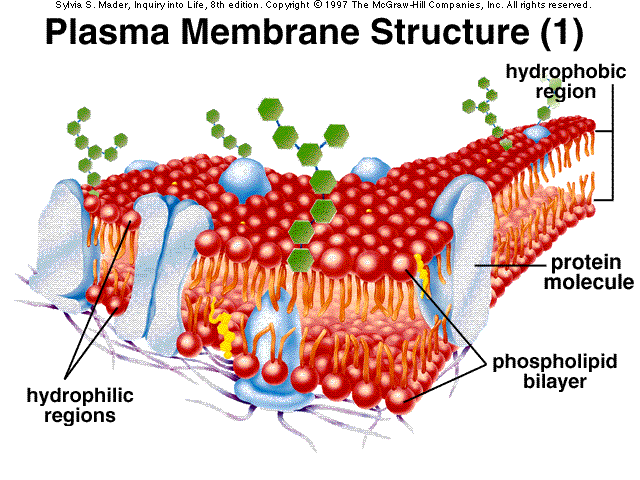Learning Resource 05. The Learning Resource goal is to use the Internet and become independent of the textbook. It is a project in progress...  The scale figure is included to remind you about the level of scale of the structures we are discussing.  Encloses the cell from its surrounding -- different composition compared to the surrounding yet the cell can --- eliminate waste --- take up nutrients (& toxins & pollutants)  Fluid in texture Mosaic in composition
1. Diffusion. Passive transport -- does NOT require energy. Movement from a high concentration to a low concentration -- e.g., paint spreading in a bucket or water -- or -- transportation of oxygen into the body. def. Diffusion: Net movement of molecules from a place of higher concentration, to a place of lower concentration (movement DOWN a concentration gradient) 2. Facilitated Diffusion. Passive transport helped with membrane proteins -- does NOT require energy. Movement from a high concentration to a low concentration -- e.g., nutrient transport through a membrane protein 3. Active transport. "Active" transport -- requires energy. Movement from a LOW concentration to a HIGH concentration -- e.g., sodium-potassium pump in the cell membrane.
def. Osmoregulation: The maintenance of an optimal and constant water balance (osmotic pressure) in the body of organisms living in hypertonic, hypotonic and terrestrial environments. def. Osmosis: Diffusion (net movement of molecules from a place of higher concentration to a place of lower concentration) of water through a semi-permable membrane. def. Osmotic Pressure: A measure of the tendency of a solution to take up water when separated from pure water by a semi-permeable membrane.  1. Isotonic solutions 2. Hypotonic solutions 3. Hypertonic solutions  Example: Water balence in RBCs  1. ISOTONIC water solution (e.g., blood plasma compared to human cells) Water flows across the membrane at the same rate (NORMAL, STABLE) 2. HYPERTONIC water solution (e.g. ocean salt water comp. to human cells) water flows out of the cell at a faster rate (LOSS OF WATER, SHRIVEL, DIE) 3. HYPOTONIC water solution (e.g. pond fresh water comp. to human cells) ‡ water flows into the cell at a faster rate (GAIN WATER, SWELL, BURST) What is isotonic solutions can vary between different animals e.g., Isotonic Salt Concentration in Humans -- 0.7% salt Isotonic Salt Concentration in Jellyfish -- 3.5% salt (same as the sea water) • Animals must live in an environment ISOTONIC to their cells, unless they have a method to balance water gain or water loss -- OSMOREGULATION 
 In review: In animal cells Isotonic conditions are normal, and in plant cells hypotonic conditions are normal...  - - - Khan Academy You Tube - - - - - - Khan Academy You Tube - - -COMMENT ON THE YOUTUBE: we have a test tomorrow and i was really confused about? osmosis and diffusion. but now i understand it. thanks alot. Our knowledge of the plasma membrane is important in understanding the diseases such as diabetes, cystic fibrosis, some cancers, and high cholesterol count. This is dependent on knowledge of the molecules that make up the cell. (Source: Mader, S.S. 2010. Biology. Ed. 10. Used for educational purpose.) |